Bluetooth Qualification
This document introduces how to qualify and list your own products with minimal effort based on existing Realtek RTL87xx series and RTL88xx series qualified Designs. To sell a product with the Bluetooth® logo, the company must first ensure the product conforms to the Bluetooth Core Specification, and what's more, the product has been listed and the declaration has been completed.
For products based on the Realtek Bluetooth audio chipset families (RTL87xx series/RTL88xx series) Design, a new Design should be created by referring to the Design. The Realtek Bluetooth dual mode audio solution supports full scope Bluetooth LE Audio profiles and services as well as AuracastTM capability, featured with multiple RFPHY s and LC3 codec will be implemented for next Bluetooth audio generation in various use cases.
Bluetooth® Compliance Program
Only members of the Bluetooth SIG are licensed to use the Bluetooth word mark, figure mark, and combination mark (collectively, the 'Bluetooth Trademarks'), as agreed to the Bluetooth Trademark License Agreement (BTLA). Members may use the Bluetooth Trademarks in association with their products and services, as well as in association with their company to promote their membership in the Bluetooth SIG. When the trademarks are used in association with a product, that product must have undergone and properly completed the Bluetooth Qualification Process.
Bluetooth® Compliance Program includes Bluetooth qualification and declaration which members complete to demonstrate and declare the products they build, qualify, brand, or mark and identify its logo, and comply with the requirements of the Bluetooth license agreements.
The two licensing agreements are: Bluetooth Patent & Copyright License Agreement and Bluetooth Trademark License Agreement. Bluetooth Patent & Copyright License Agreement is a reciprocal license between each Bluetooth SIG Member to the intellectual property that each member owns. Bluetooth Trademark License Agreement is a license between the Bluetooth SIG (owner of the Bluetooth Trademark) and each member with authorized use of the Bluetooth Trademarks.
Companies are encouraged to review the conditions of the license agreements and consult their legal counsel with any questions regarding the applicable requirements. If a company wants to use the Bluetooth Trademarks, the company must become a Bluetooth SIG member and complete the Bluetooth Compliance Program.
Terminology
Name |
Definition |
Description |
|---|---|---|
Bluetooth SIG |
Bluetooth Special Interest Group |
Bluetooth SIG is a non-profit organization responsible for overseeing the development of Bluetooth standards and the licensing of Bluetooth technologies. Founded in 1998, it comprises thousands of companies that work together to create and maintain Bluetooth technology. |
BQTF |
Bluetooth Qualification Test Facility |
An accredited test facility that can perform testing and produce test results for any Member, and Bluetooth SIG will accept the results for the purposes of the Bluetooth Qualification Process. |
BRTF |
Bluetooth Recognized Test Facility |
An accredited test facility that can perform testing and produce test results for itself, and Bluetooth SIG will accept the results for purposes of the Bluetooth Qualification Process. |
Bluetooth Specifications |
All specifications and updates to specifications adopted in accordance with the Bylaws of Bluetooth SIG. |
|
Complete Layer |
An implementation contains a complete layer if the implementation includes, for that layer, all mandatory features, all the mandatory elements of any optional feature that is included, and any features that are conditionally required. |
|
Core Configuration |
The Bluetooth Core Specification, where also the following terms, used in this document, are specified: Core-Complete Configuration, Core-Controller Configuration, and Core-Host Configuration. |
|
Core Layer |
A manufacturer that lists a product on the End Product Listing. |
|
Design |
An implementation of one or more Bluetooth Specifications. |
|
DN |
Design Number |
A reference number issued for each unique Design that is issued the first time a Product using that Design completes the Bluetooth Qualification Process (Former QDID in QPRD 2.3). |
ICS |
Implementation Conformance Statement |
The document produced by the Bluetooth SIG for each Bluetooth Specification that identifies the features of that Bluetooth Specification. |
ILD |
Inter-Layer Dependency |
A Bluetooth Specification requirement in one Layer that is dependent on one or more features or elements of a feature implemented in another Layer. |
Member |
An entity who has executed the Bluetooth SIG's membership agreements and has not withdrawn their membership or otherwise had their membership terminated. |
|
Product Publication Date |
The date requested by the Member, when the Qualified Product details are visible to the public and other Members in the Qualified Product database, which may not be later than 90 days after submission. |
|
Product Qualification Date |
The date that the Bluetooth SIG notifies the Member that the Product has successfully completed the Bluetooth Qualification Process. |
|
PTS |
Profile Tuning Suite |
A PC-based 'black box' test tool developed by the Bluetooth SIG. It is a conformance test system that can be used for conformance testing of Host features and Bluetooth profiles. |
RN |
Receipt Number |
A unique reference number issued as proof of payment of an administrative fee paid by a Member to complete the Bluetooth Qualification Process (Former DID in QPRD 2.3). |
RF PHY |
RF Physical Layer |
The RF PHY is the portion of a chip or circuit that contains the physical radio transmitter and receiver (transceiver). |
SoC |
System on Chip |
A system on chip is an integrated circuit that integrates all components of a computer or other electronic system into a single chip. It may contain digital, analog, mixed signal, and often radio functions. |
TCRL |
Test Case Reference List |
For each Bluetooth Specification, the sheet within the TCRL Package that identifies the applicable versions of the TS and ICS to be used in the Bluetooth Qualification Process for Designs that implement that Bluetooth Specification. |
X2Core Layer |
A single Bluetooth Specification that is not a Bluetooth Core Specification. |
Listing & Submission
To demonstrate that a product complies with the Bluetooth Specification(s), each member must for each of its products:
Identify the product, the Design included in the product, the Bluetooth Specifications that the Design implements, and the features of each implemented specification.
Complete the Bluetooth Qualification Process by submitting the required documentation for the product under a user account belonging to the company.
For a product to complete the Bluetooth Qualification Process, the Member must submit the required documentation for the product under a Bluetooth SIG user account belonging to the same Member completing the Bluetooth Qualification Process. The Bluetooth Qualification Process consists of the phases shown below:

Qualification Process
The Bluetooth Qualification Process is completed in SIG Qualification Workspace. And this document will walk you through each of the phases and help you determine the proper option for your product in the Specify the Design phase.
Any Member incorporating Bluetooth wireless technology into their products is required to fill out a listing for the Qualified Design they have created, modified, branded, or used, as well as a Declaration of Compliance (DoC).
Note
A listing may include multiple products if each product implements the same Qualified Design referenced in the DoC.
Qualified Audio Designs
DN/QDID |
Design Name |
Core Configuration |
|---|---|---|
Q361739 |
Realtek Bluetooth 6.0 Audio Solution |
BR/EDR/LE Core-Complete |
Q304164 |
Realtek Bluetooth 5.4 Audio Solution |
BR/EDR/LE Core-Complete |
195471 |
Realtek Bluetooth 5.3 Audio Solution (2022) |
End Product |
Here are only some commonly used IDs listed. For more information, please visit the Bluetooth Technology website: https://qualification.bluetooth.com/MyProjects/ListingsSearch
Subset
The Bluetooth SIG deems that any implementation of the qualified Design can disable one or more profiles, protocols, services, roles or optional features as qualified by the Subset implementation.
Subset Design must still meet the requirements of the same Core Configuration (if applicable).
A subset Design cannot add layers or features, and the TCRL Package versions cannot be changed.
Note
It is the Member's responsibility to ensure that all implementations, for which qualified status is claimed, meet the Bluetooth Qualification Requirements (or applicable subset thereof) as of the date of the initial qualified Design.
The Realtek Bluetooth dual mode audio solution supports full scope Bluetooth LE Audio profiles and services as well as AuracastTM capability, featured with multiple RFPHYs and also various traditional audio profiles which can refer to the support tables: GATT Profiles and Services, LE Audio Profiles and Services or Traditional Profiles.
If the end product only implements some functions, Realtek can create a subset based on the certified qualification, once approved, this subset ID can used for the product certification without modification.
To create a subset of a design, please provide the following information:
Platform: Please provide the product platform information.
IC: Please provide the product IC information.
LE Audio: Please clarify whether this prodcut supports LE Audio or not.
Product type: Please clarify the product type.
Supported Profiles: Please specify the profiles the product needs to support.
Controller: Please specify if there are any specific features that need to be removed.
Datasheet: Please provide the Bluetooth version of the product.
Embedded Chip Types
Realtek offers two types of embedded chips: Module and CoB (Chip On Board). The end product manufacturers should confirm which type of chip is used.
Solution of Two Embedded Chip Types
Use a Single Existing Design
Whether Module or CoB type, if the end product uses Realtek solution(s), and no extra features (ICS features) are added to the Design and no PCB/BOM modifications, just a listing of branding/rebranding products is needed.
As Realtek has completed the original qualification and declaration, you can directly inherit the qualification evidence from Realtek as long as the end product manufacturers support profiles that are consistent with Realtek's original certification.
This option applies to a Member qualifying a Product that includes an existing Design that has a DN, QDID, or DID and that Design has not been modified (e.g., rebranding a Qualified Product from another Member).
The Design identified by the DN, QDID, or DID may only implement Bluetooth Specifications that are active or deprecated at the time of Submission. No modifications may be made to the Design, including changes to the ICS Form.
Listing
Note
In this document, we will use Bluetooth 5.4 product as an example to demonstrate how to complete the listing process.
Before getting started, ensure the following information.
If using Realtek Bluetooth 5.4 audio solution, and no modifications will be made.
The DN of the Qualified Design is Q304164.
Once this information is available, you will be able to properly reference the Qualified Design(s) by listing your products and completing the DoC (Declaration of Compliance). Realtek Bluetooth 5.4 audio solution supports full scope Bluetooth LE Audio profiles and services as well as AuracastTM capability, featuring multiple RFPHYs and LC3 codec implemented for the next Bluetooth audio generation in various use cases.
The following is an instruction on how to complete the Listing by using an existing qualified Design(s) or branding/rebranding another member's product.
Login to https://www.bluetooth.com/.
-
Click My Blue button, then select Qualification Workspace.
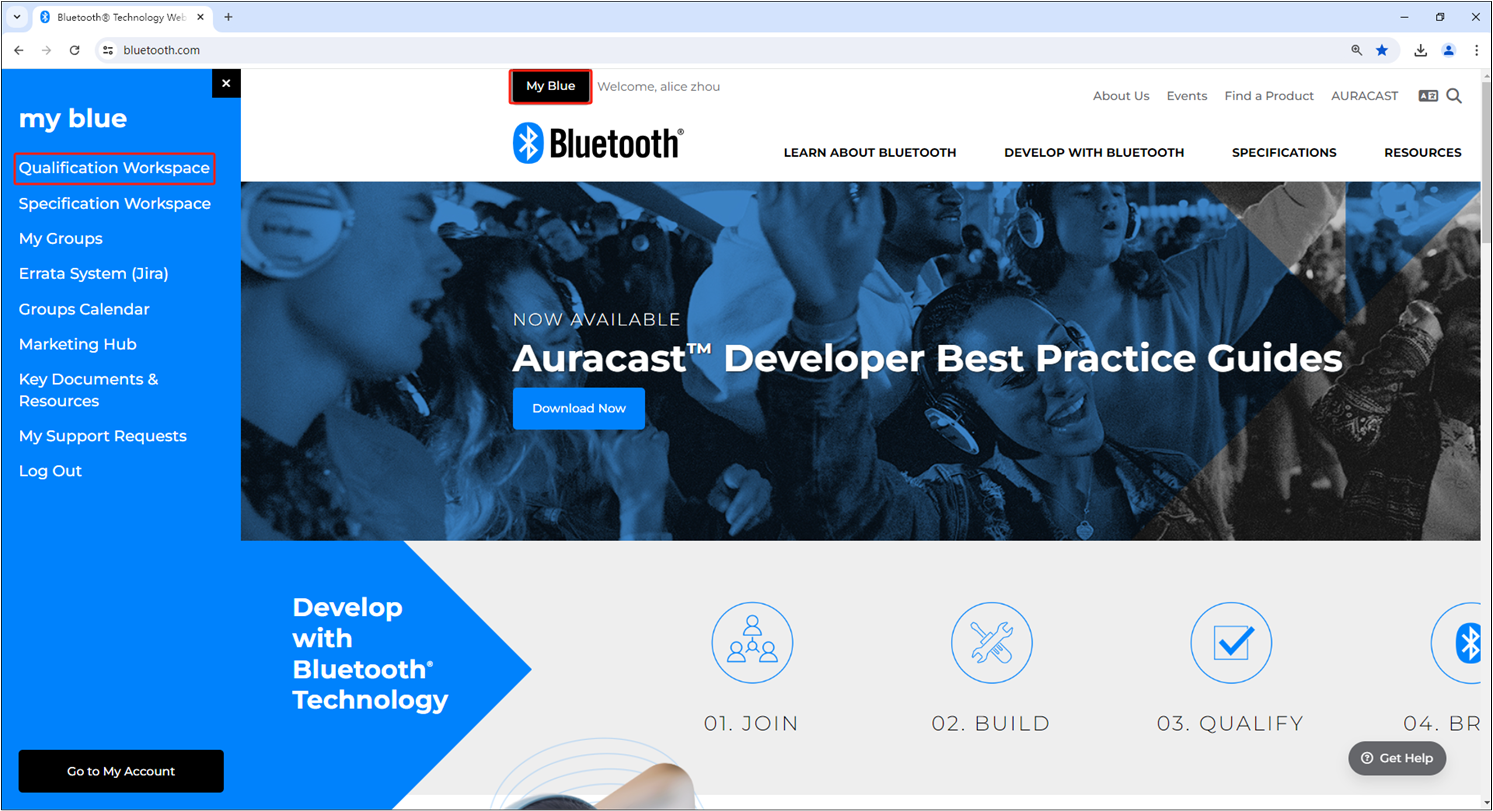
Qualification Workspace
-
Click Start the Bluetooth Qualification Process button, start the qualification process.
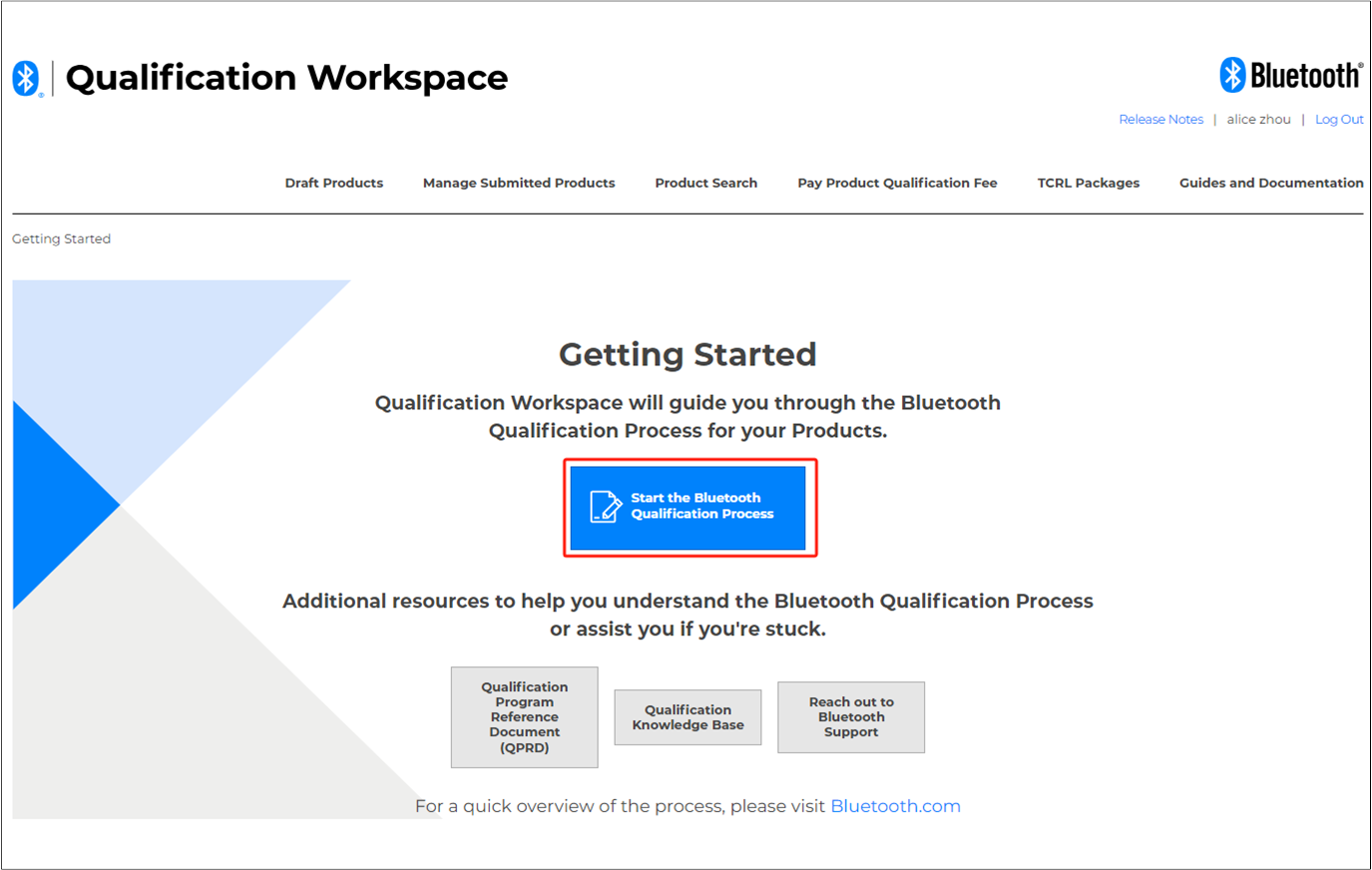
Get Start
-
Let's get started. Provide information about your Product(s).
Product Name
Product Description
Model Number
Product Publication Date
If you have additional details, such as the Product website, fill in the corresponding field.
If the Product will be visible for other users with a user account issued under the same Member to view before the Product Publication Date.
If you want to qualify any additional Product(s) that use the same Design, select Import multiple products or Add an individual Product; otherwise, select No, I do not.
If you want to qualify Product(s) that use the same Design already included in an existing Qualified Product from your Member company, select Yes, I do; otherwise, select No, I do not.
The Product name and model number provided by the Member during the Bluetooth Qualification Process must match the Product name and model number used by the Member when marketing, advertising, distributing, and selling the Product.
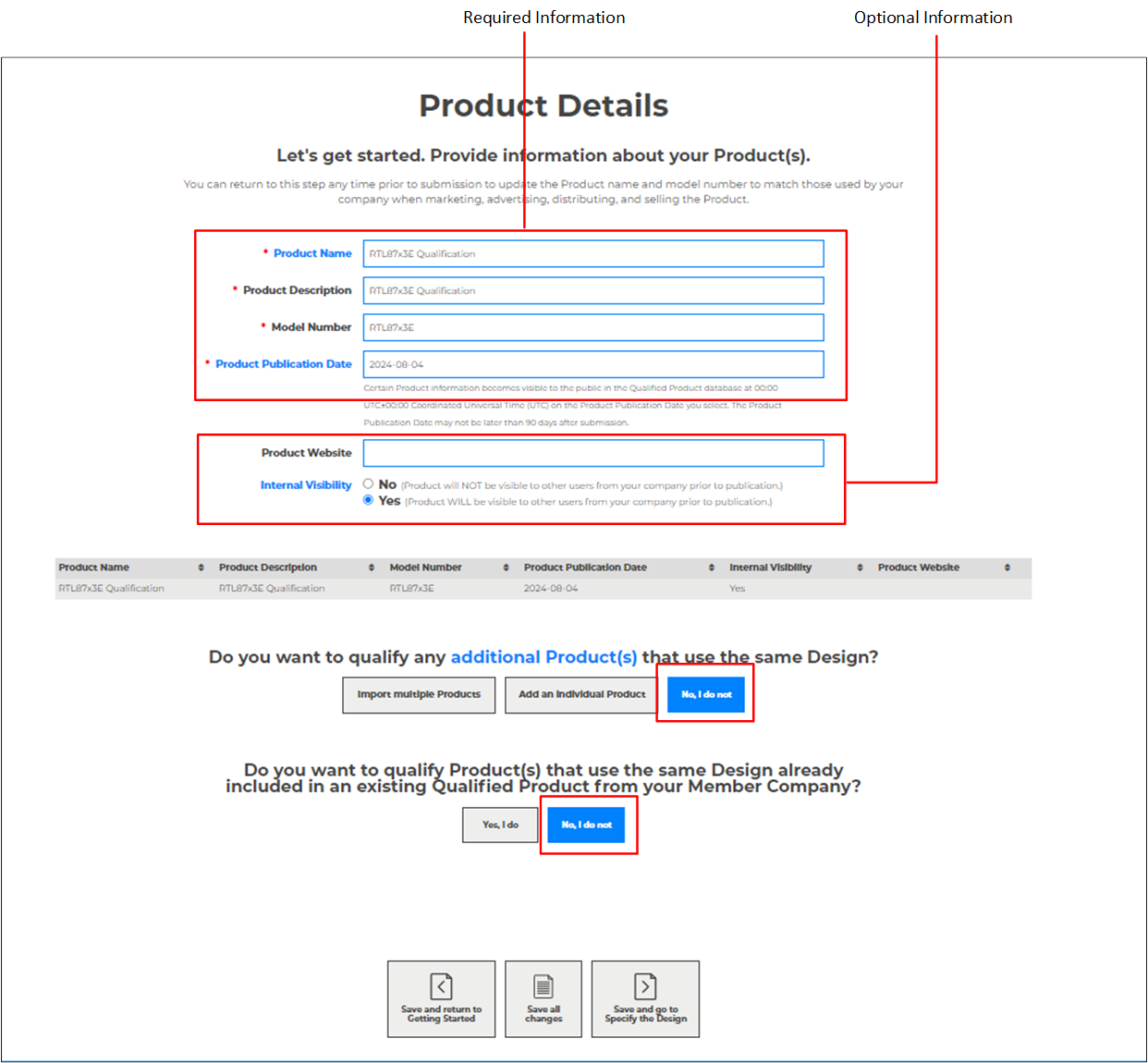
Product Details
Click Save and go to Specify the Design to proceed to the next step.
-
Specify the Design: Select Yes, I do for existing Design(s), enter DN Q304164, and then click I'm finished entering DNs, then select use this Design without modifications.

Specify Design
Click Save and go to Product Qualification Fee to proceed to the next step.
-
Product Qualification Fee
Members are required to pay an administrative fee to complete the Bluetooth Qualification Process. If an administrative fee is required, then the Bluetooth SIG issues a Receipt Number upon payment by the Member. The Member will provide the Receipt Number as proof of payment with their submission. After all necessary documentation is prepared and the administrative fee is paid, then the Member may proceed to submission. Members who require the Bluetooth SIG to issue an invoice for an administrative fee will need to take into account the additional time it takes to issue an invoice.

Qualification Fee
Click Save and go to Submission to proceed to the next step.
-
Submission: Review the provided information and complete the submission.
Please carefully review all information for accuracy. All status alerts must be resolved before submitting your Product, provided that you may submit your Product with a valid and approved Test Coverage Waiver that indicates the requirement has been waived. By typing your name or other symbol of signature into the 'Signature' field to finish the submission.
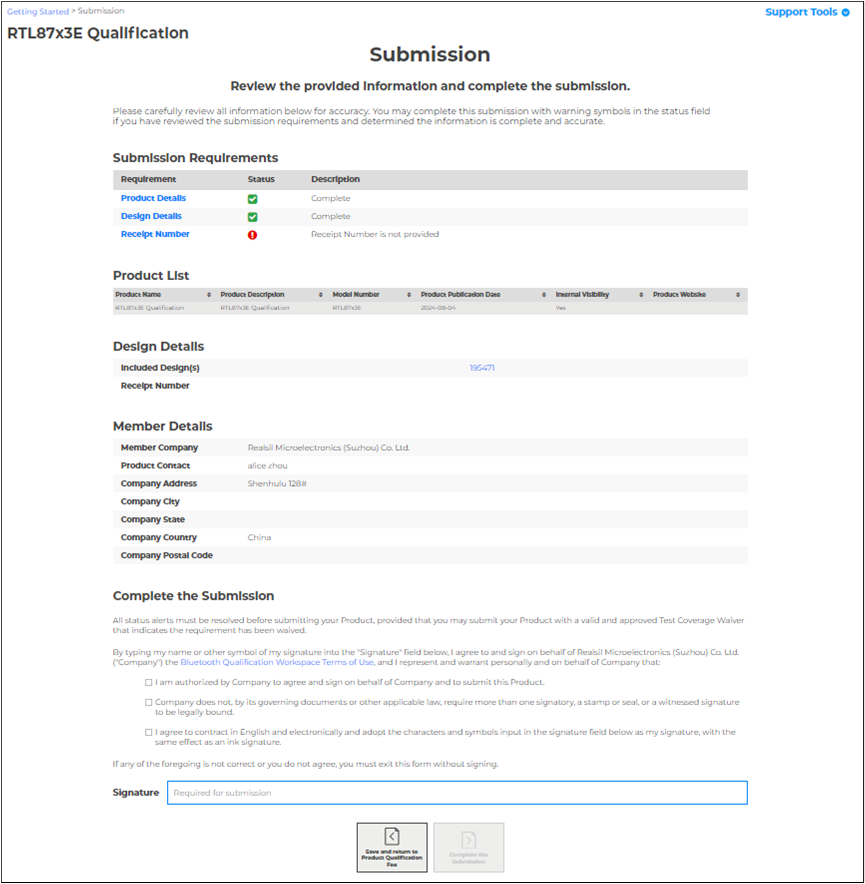
Submission
Create a New Design
If end product manufacturers want to modify or add some new features or own your DN, this qualification scheme should be used.
The end product manufacturers should finish the RF test (Recommended) and profiles test not covered by the QDIDs/DNs.
Testing
The testing of Bluetooth RF PHY can only be executed at a BQTF. Select the profiles that you should support as the Profiles supported in the Realtek RTL87xx series and RTL88xx series chipset to implement profiles with or without the assistance of BQTF.
Listing
Before listing, a Member must provide the following information:
Design name (Optional, the Bluetooth SIG online tools will default to the Product name if the Member does not specify a Design name).
If other Members are allowed to include the new Design in their Product (after it has been published in the Qualified Product database).
If other users with accounts issued under the same Member are allowed to include the new Design in their Product (after it has been published in the Qualified Product database).
The following is an instruction on how to complete the Listing with a new Design or changing an existing Qualified Design.
Login to https://www.bluetooth.com/.
-
Click My Blue button, then select Qualification Workspace.

Qualification Workspace
-
Click Start the Bluetooth Qualification Process button, start the qualification process.

Get Start
-
Let's get started, provide information about your Product(s):
Product Name
Product Description
Model Number
Product Publication Date
If you have additional details, such as the Product website, fill in the corresponding field.
If the Product will be visible for other users with a user account issued under the same Member to view before the Product Publication Date.
If you want to qualify any additional Product(s) that use the same Design, select Import multiple products or Add an individual Product, otherwise, select No, I do not.
If you want to qualify Product(s) that use the same Design already included in an existing Qualified Product from your Member company, select Yes, I do, otherwise, select No, I do not.
The Product name and model number provided by the Member during the Bluetooth Qualification Process must match the Product name and model number used by the Member when marketing, advertising, distributing, and selling the Product.

Product Details
Click Save and go to Specify the Design to proceed to the next step.
-
Specify the Design: Select Yes, I do for existing Design(s), enter Host solution 188777, Controller solution 185410, and LC3 solution 167204 if needed. Then, click I'm finished entering DNs, select Modify or add set to this design.
For the Design, a Member must provide the following information:
Design name (Optional, the Bluetooth SIG online tools will default to the Product name if the Member does not specify a Design name).
If other Members are allowed to include the new Design in their Product (after it has been published in the Qualified Product database).
If other users with accounts issued under the same Member are allowed to include the new Design in their Product (after it has been published in the Qualified Product database).
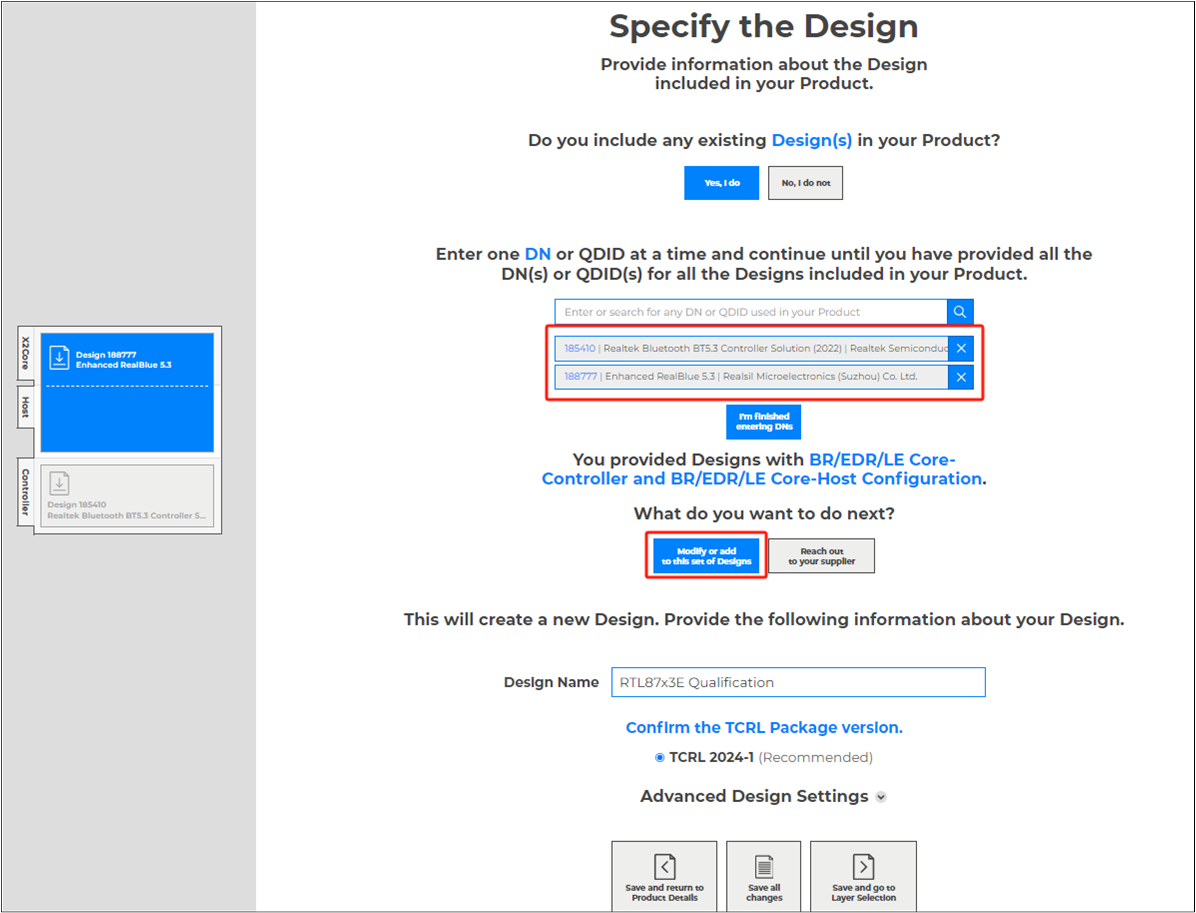
Specify Design Modified
Click Save and go to Layer Selection to proceed to the next step.
-
Layer Selection: Specify the Layers and desired Core Configuration if applicable.
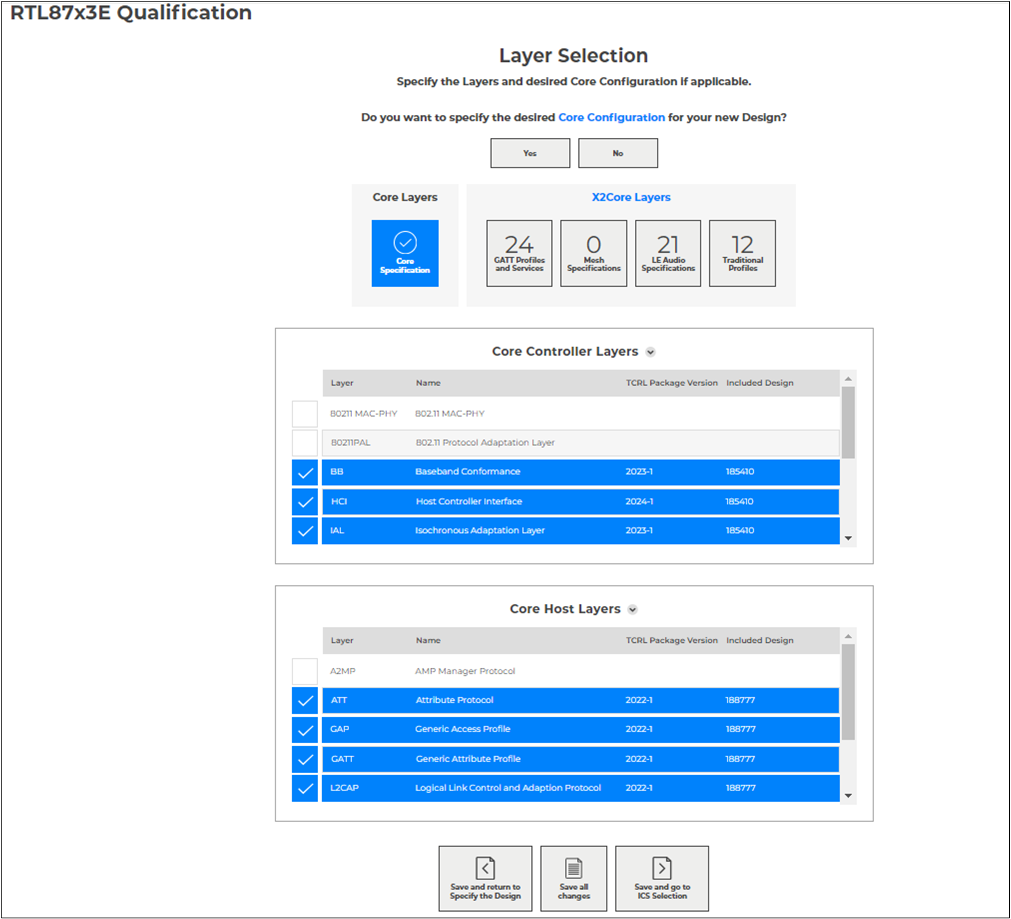
Layer Selection
Click Save and go to ICS Selection to proceed to the next step.
-
ICS Selection: Specify the Design features, then run the consistency check.
The ICS Form for the new Design must pass the consistency check performed by the tools provided by the Bluetooth SIG. The consistency check determines whether the ICS Form is consistent with the requirements of the corresponding Bluetooth Specification(s) and any applicable deprecation and withdrawal policies and whether the ICS Form correctly shows support for:
One or more Complete Layers.
The ILDs between Layers included in the Design, based on the latest TCRL Package version used among the included Designs.
Applicable Core Configuration (including transport compatibility).
If the Bluetooth SIG tool identifies any inconsistencies, then the Member must address the inconsistencies by correcting the ICS Form so that it passes the consistency check or by providing a TCW that indicates the requirement has been waived before submission.
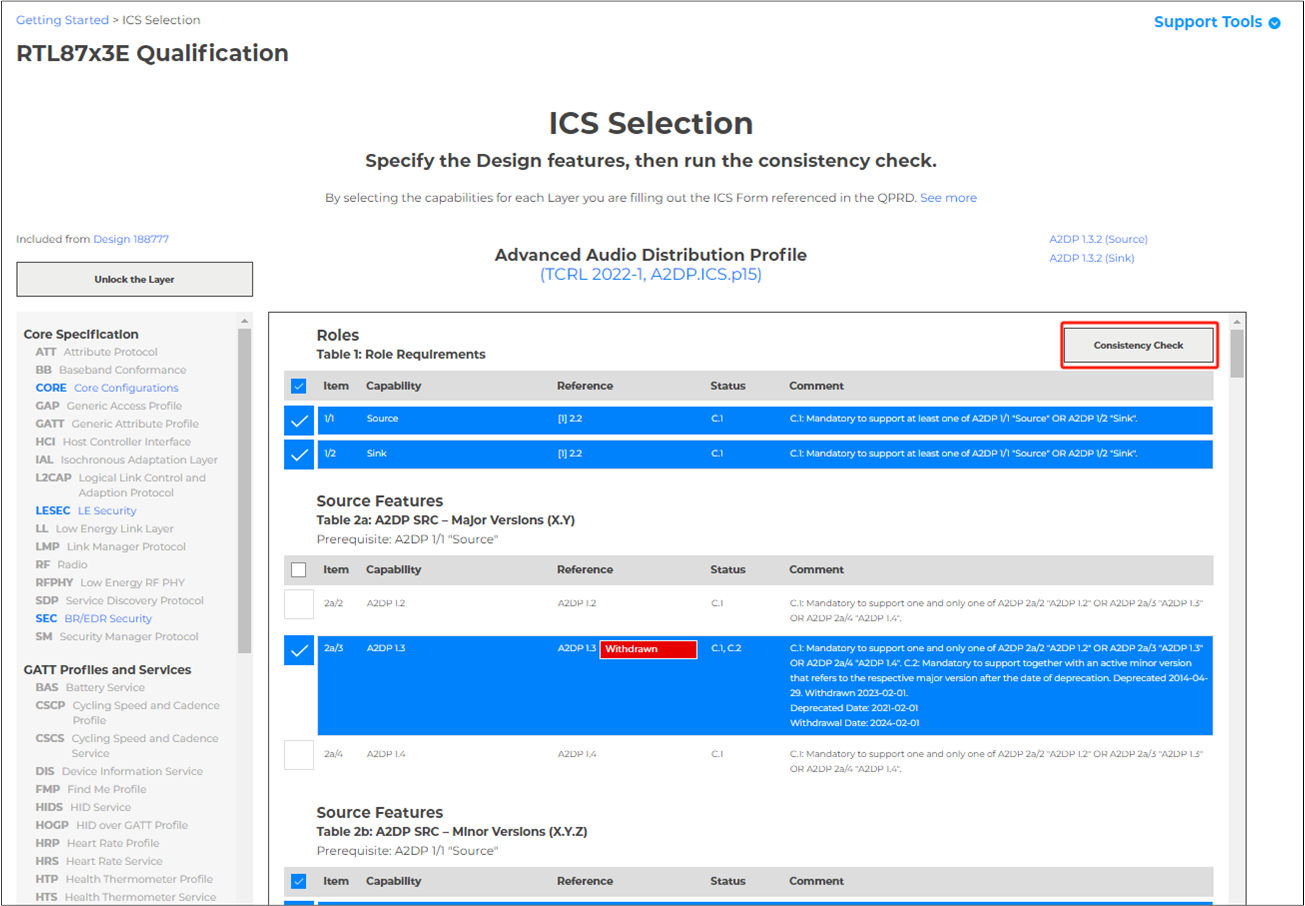
ICS Selection
Click Save and go to Test Plan and Documentation to proceed to the next step.
-
Test Plan and Documentation
If, based on the ICS Form, testing is required, then the Bluetooth SIG tool will generate a test plan, which includes all test cases for the new and modified Layers and any applicable IOPT test cases. The generated test plan will be based on the ICS Form and test case mapping table of the TCRL Package version specified by the Member for each Layer. If no test plan is generated, then the Member will skip testing, test declaration, and test reports.
When a Test Plan is generated, the Member must follow the test requirements defined in QPRD and execute each mandatory test case according to the test case category requirements specified in the test plan. After finishing the test, upload the test declaration and test report(s).
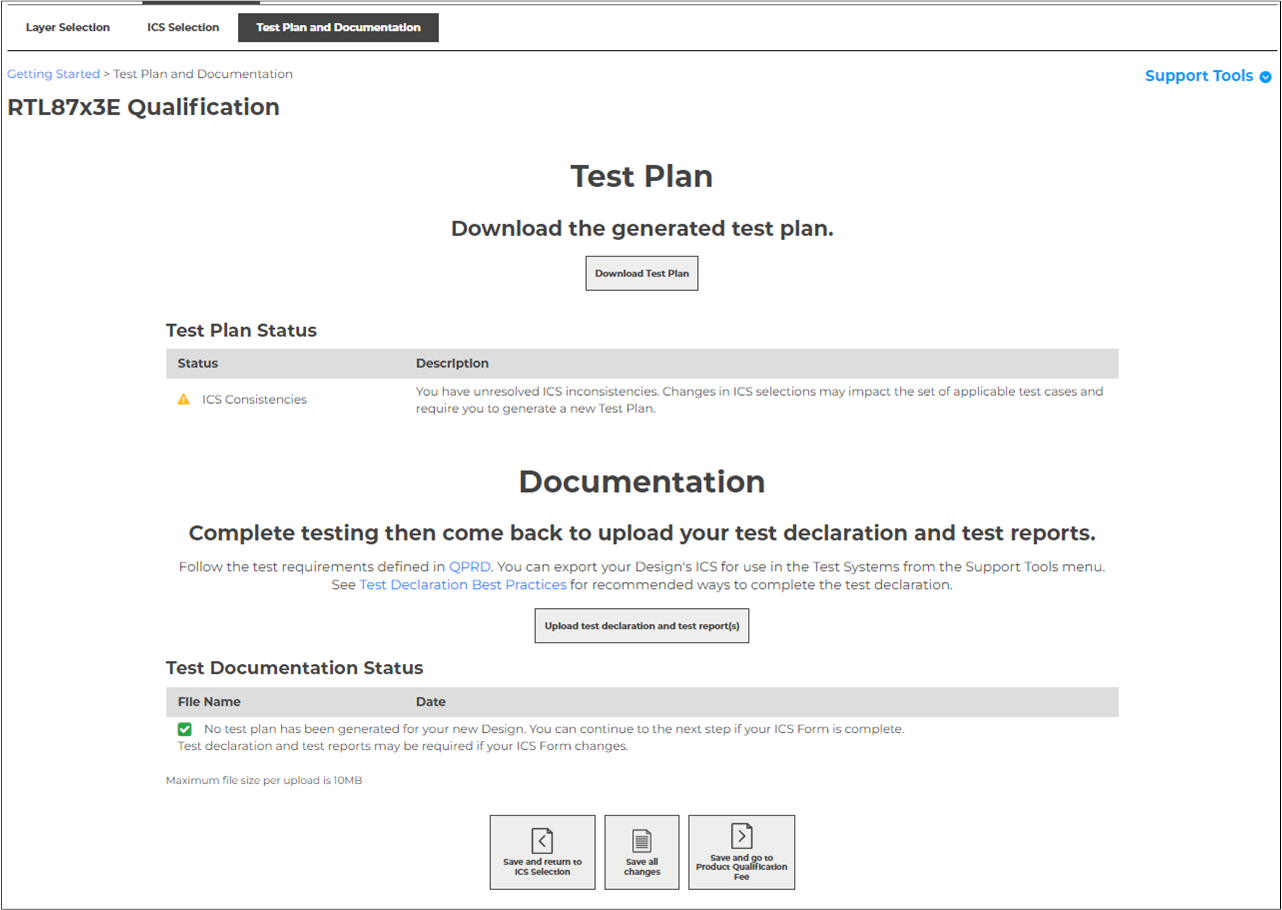
Test Plan and Documentation
Click Save and go to Product Qualification Fee to proceed to the next step.
-
Product Qualification Fee
Members are required to pay an administrative fee to complete the Bluetooth Qualification Process.
If an administrative fee is required, then the Bluetooth SIG issues a Receipt Number upon payment by the Member. The Member will provide the Receipt Number as proof of payment with their submission. After all necessary documentation is prepared and the administrative fee is paid, then the Member may proceed to submission. Members who require the Bluetooth SIG to issue an invoice for an administrative fee will need to take into account the additional time it takes to issue an invoice.

Qualification Fee
Click Save and go to Submission to proceed to the next step.
-
Submission: Review the provided information and complete the submission.
Please carefully review all information for accuracy. All status alerts must be resolved before submitting your Product, provided that you may submit your Product with a valid and approved Test Coverage Waiver that indicates the requirement has been waived. By typing your name or other symbol of signature into the 'Signature' field to finish the submission.
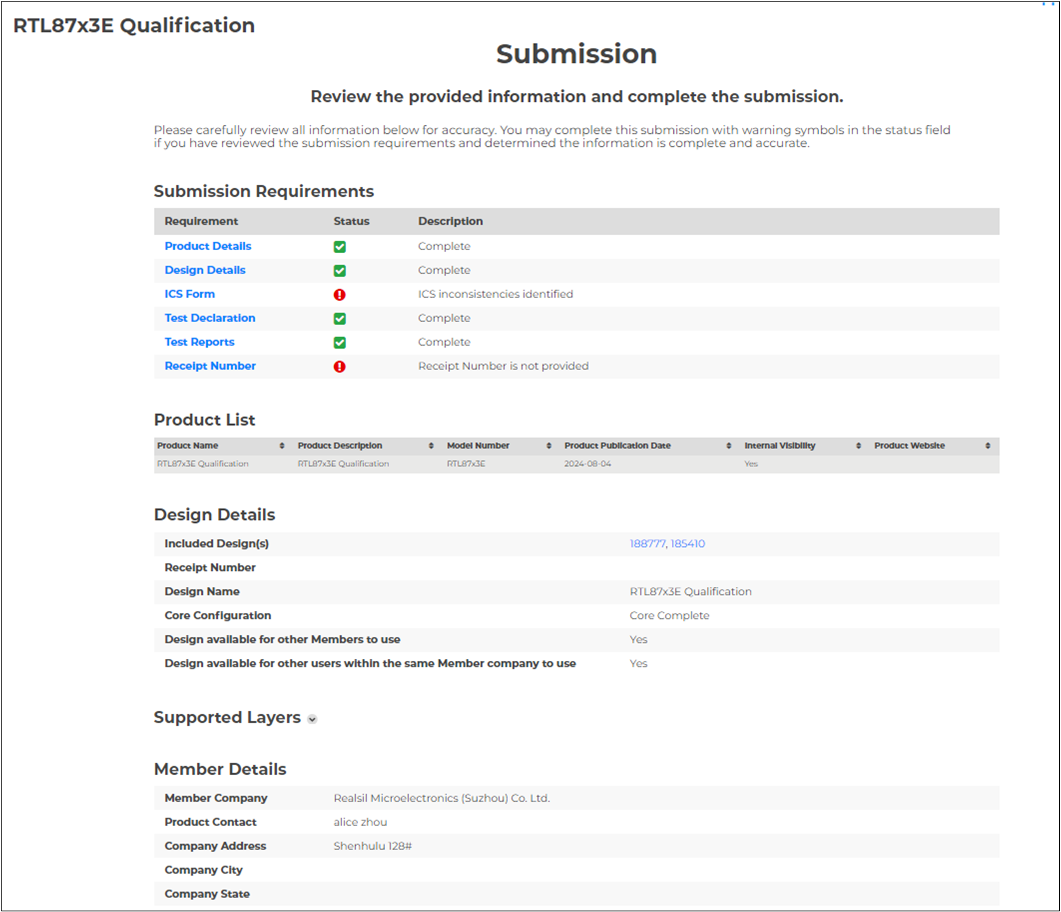
Submission
Then start the listing process. The listing process is the same as Use a Single Existing Design.
Supported Profiles
All the profiles, services and versions listed are supported in Realtek Bluetooth 6.0 audio solution Q361739. For detailed versions of other QDIDs, please refer to the specific list information on the Bluetooth official website.
Profiles |
Full Name |
Role |
Version |
|---|---|---|---|
BAS |
Battery Service |
1.1 |
|
CSCP |
Cycling Speed and Cadence Profile |
Sensor |
1.0.1 |
CSCS |
Cycling Speed and Cadence Service |
1.0.1 |
|
DIS |
Device Information Service |
1.2 |
|
FMP |
Find Me Profile |
Target (Server) |
1.0 |
HIDS |
HID Service |
1.0 |
|
HOGP |
HID over GATT Profile |
Server |
1.0 |
HRP |
Heart Rate Profile |
Sensor |
1.0 |
HRS |
Heart Rate Service |
1.0 |
|
HTP |
Health Thermometer Profile |
Thermometer |
1.0 |
HTS |
Health Thermometer Service |
1.0 |
|
IAS |
Immediate Alert Service |
1.0 |
|
IPSP |
Internet Protocol Support Profile |
Node |
1.0 |
LLS |
Link Loss Service |
1.0.1 |
|
LNP |
Location and Navigation Profile |
Sensor |
1.0.1 |
LNS |
Location and Navigation Service |
1.0.1 |
|
OTP |
Object Transfer Profile |
Server Client |
1.0 |
OTS |
Object Transfer Service |
1.0 |
|
PXP |
Proximity Profile |
Reporter |
1.0.1 |
RSCP |
Running Speed and Cadence Profile |
Sensor |
1.0.1 |
RSCS |
Running Speed and Cadence Service |
1.0.1 |
|
SCPP |
Scan Parameters Profile |
Server |
1.0 |
SCPS |
Scan Parameters Service |
1.0 |
|
TPS |
TX Power Service |
1.0 |
Profiles |
Full Name |
Role |
Version |
|---|---|---|---|
AICS |
Audio Input Control Service |
1.0.1 |
|
ASCS |
Audio Stream Control Service |
1.0.1 |
|
BAP |
Basic Audio Profile |
Unicast Server Unicast Client Broadcast Source Broadcast Sink Scan Delegator Broadcast Assistant |
1.0.2 |
BASS |
Broadcast Audio Scan Service |
1.0.1 |
|
CAP |
Common Audio Profile |
Acceptor Initiator Commander |
1.0.1 |
CAS |
Common Audio Service |
1.0 |
|
CCP |
Call Control Profile |
Call Control Server Call Control Client |
1.0 |
CSIP |
Coordinated Set Identification Profile |
Set Member Set Coordinator |
1.0.1 |
CSIS |
Coordinated Set Identification Service |
1.0.1 |
|
HAP |
Hearing Access Profile |
1.0.1 |
|
HAS |
Hearing Access Service |
1.0.1 |
|
LC3 |
Low Complexity Communication Codec |
LC3 Encoder LC3 Decoder LC3 Encoder-Decoder |
1.0.1 |
MCP |
Media Control Profile |
Server Client |
1.0 |
MCS |
Media Control Service |
1.0.1 |
|
MICP |
Microphone Control Profile |
Controller Device |
1.0 |
MICS |
Microphone Control Service |
1.0 |
|
PACS |
Published Audio Capabilities Service |
1.0.2 |
|
PBP |
Public Broadcast Profile |
Public Broadcast Source Public Broadcast Sink Public Broadcast Assistant |
1.0.1 |
TBS |
Telephone Bearer Service |
1.0 |
|
TMAP |
Telephony and Media Audio Profile |
Call Gateway Call Terminal Unicast Media Sender Unicast Media Receiver Broadcast Media Sender Broadcast Media Receiver TMA Client TMA Server |
1.0.1 |
VCP |
Volume Control Profile |
Renderer Controller |
1.0 |
VCS |
Volume Control Service |
1.0.1 |
|
VOCS |
Volume Offset Control Service |
1.0.1 |
Profiles |
Full Name |
Role |
Version |
|---|---|---|---|
A2DP |
Advanced Audio Distribution Profile |
Source Sink |
1.4 |
AVCTP |
Audio/Video Control Transport Protocol |
Controller Target |
1.4 |
AVDTP |
Audio/Video Distribution Transport Protocol |
Source Sink Initiator Acceptor |
1.3 |
AVRCP |
Audio/Video Remote Control Profile |
Controller Target |
1.6.3 |
DID |
Device Identification |
1.3 |
|
GAVDP |
Generic Audio/Video Distribution Profile |
Initiator Acceptor Delay Reporting Initiator |
1.3 |
HFP |
Hands-Free Profile |
1.9 |
|
HSP |
Headset Profile |
1.2 |
|
IOPT |
Interoperable Product Testing |
||
MAP |
Message Access Profile |
1.4.3 |
|
PBAP |
Phone Book Access Profile |
1.2.3 |
|
RFCOMM |
RFCOMM |
1.2 |
|
SPP |
Serial Port Profile |
DevA DevB |
1.2 |
Reference
QPRD_PROC_v3